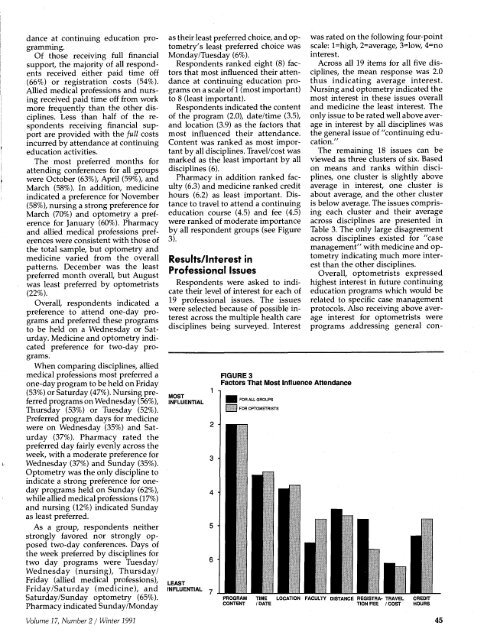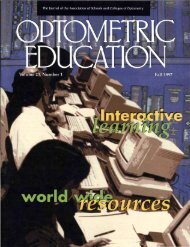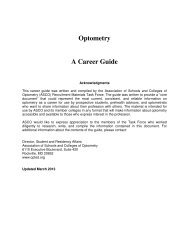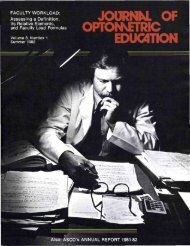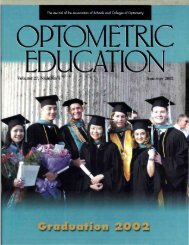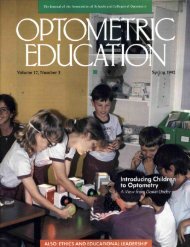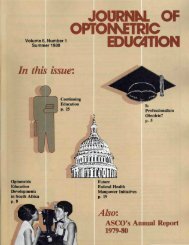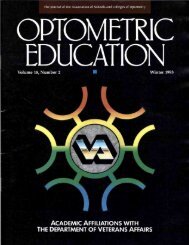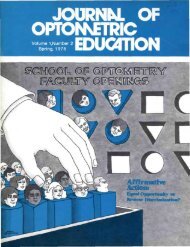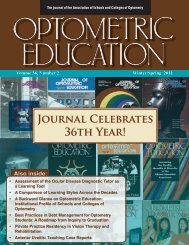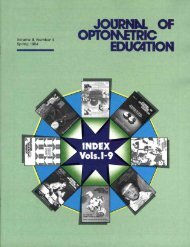Winter 1992, Volume 17, Number 2 - Association of Schools and ...
Winter 1992, Volume 17, Number 2 - Association of Schools and ...
Winter 1992, Volume 17, Number 2 - Association of Schools and ...
Create successful ePaper yourself
Turn your PDF publications into a flip-book with our unique Google optimized e-Paper software.
dance at continuing education programming.<br />
Of those receiving full financial<br />
support, the majority <strong>of</strong> all respondents<br />
received either paid time <strong>of</strong>f<br />
(66%) or registration costs (54%).<br />
Allied medical pr<strong>of</strong>essions <strong>and</strong> nursing<br />
received paid time <strong>of</strong>f from work<br />
more frequently than the other disciplines.<br />
Less than half <strong>of</strong> the respondents<br />
receiving financial support<br />
are provided with the full costs<br />
incurred by attendance at continuing<br />
education activities.<br />
The most preferred months for<br />
attending conferences for all groups<br />
were October (63%), April (59%), <strong>and</strong><br />
March (58%). In addition, medicine<br />
indicated a preference for November<br />
(58%), nursing a strong preference for<br />
March (70%) <strong>and</strong> optometry a preference<br />
for January (60%). Pharmacy<br />
<strong>and</strong> allied medical pr<strong>of</strong>essions preferences<br />
were consistent with those <strong>of</strong><br />
the total sample, but optometry <strong>and</strong><br />
medicine varied from the overall<br />
patterns. December was the least<br />
preferred month overall, but August<br />
was least preferred by optometrists<br />
(22%).<br />
Overall, respondents indicated a<br />
preference to attend one-day programs<br />
<strong>and</strong> preferred these programs<br />
to be held on a Wednesday or Saturday.<br />
Medicine <strong>and</strong> optometry indicated<br />
preference for two-day programs.<br />
When comparing disciplines, allied<br />
medical pr<strong>of</strong>essions most preferred a<br />
one-day program to be held on Friday<br />
(53%) or Saturday (47%). Nursing preferred<br />
programs on Wednesday (56%),<br />
Thursday (53%) or Tuesday (52%).<br />
Preferred program days for medicine<br />
were on Wednesday (35%) <strong>and</strong> Saturday<br />
(37%). Pharmacy rated the<br />
preferred day fairly evenly across the<br />
week, with a moderate preference for<br />
Wednesday (37%) <strong>and</strong> Sunday (35%).<br />
Optometry was the only discipline to<br />
indicate a strong preference for oneday<br />
programs held on Sunday (62%),<br />
while allied medical pr<strong>of</strong>essions (<strong>17</strong>%)<br />
<strong>and</strong> nursing (12%) indicated Sunday<br />
as least preferred.<br />
As a group, respondents neither<br />
strongly favored nor strongly opposed<br />
two-day conferences. Days <strong>of</strong><br />
the week preferred by disciplines for<br />
two day programs were Tuesday/<br />
Wednesday (nursing), Thursday/<br />
Friday (allied medical pr<strong>of</strong>essions),<br />
Friday/Saturday (medicine), <strong>and</strong><br />
Saturday/Sunday optometry (65%).<br />
Pharmacy indicated Sunday/Monday<br />
as their least preferred choice, <strong>and</strong> optometry's<br />
least preferred choice was<br />
Monday/Tuesday (6%).<br />
Respondents ranked eight (8) factors<br />
that most influenced their attendance<br />
at continuing education programs<br />
on a scale <strong>of</strong> 1 (most important)<br />
to 8 (least important).<br />
Respondents indicated the content<br />
<strong>of</strong> the program (2.0), date/time (3.5),<br />
<strong>and</strong> location (3.9) as the factors that<br />
most influenced their attendance.<br />
Content was ranked as most important<br />
by all disciplines. Travel/cost was<br />
marked as the least important by all<br />
disciplines (6).<br />
Pharmacy in addition ranked faculty<br />
(6.3) <strong>and</strong> medicine ranked credit<br />
hours (6.2) as least important. Distance<br />
to travel to attend a continuing<br />
education course (4.5) <strong>and</strong> fee (4.5)<br />
were ranked <strong>of</strong> moderate importance<br />
by all respondent groups (see Figure<br />
3).<br />
Results/Interest in<br />
Pr<strong>of</strong>essional Issues<br />
Respondents were asked to indicate<br />
their level <strong>of</strong> interest for each <strong>of</strong><br />
19 pr<strong>of</strong>essional issues. The issues<br />
were selected because <strong>of</strong> possible interest<br />
across the multiple health care<br />
disciplines being surveyed. Interest<br />
MOST<br />
INFLUENTIAL<br />
LEAST<br />
INFLUENTIAL<br />
FIGURE 3<br />
Factors That Most Influence Attendance<br />
^ ^ FOR ALL GROUPS<br />
[ | FOR OPTOMETRISTS<br />
PROGRAM<br />
CONTENT<br />
was rated on the following four-point<br />
scale: l=high, 2=average, 3=low, 4=no<br />
interest.<br />
Across all 19 items for all five disciplines,<br />
the mean response was 2.0<br />
thus indicating average interest.<br />
Nursing <strong>and</strong> optometry indicated the<br />
most interest in these issues overall<br />
<strong>and</strong> medicine the least interest. The<br />
only issue to be rated well above average<br />
in interest by all disciplines was<br />
the general issue <strong>of</strong> "continuing education."<br />
The remaining 18 issues can be<br />
viewed as three clusters <strong>of</strong> six. Based<br />
on means <strong>and</strong> ranks within disciplines,<br />
one cluster is slightly above<br />
average in interest, one cluster is<br />
about average, <strong>and</strong> the other cluster<br />
is below average. The issues comprising<br />
each cluster <strong>and</strong> their average<br />
across disciplines are presented in<br />
Table 3. The only large disagreement<br />
across disciplines existed for "case<br />
management" with medicine <strong>and</strong> optometry<br />
indicating much more interest<br />
than the other disciplines.<br />
Overall, optometrists expressed<br />
highest interest in future continuing<br />
education programs which would be<br />
related to specific case management<br />
protocols. Also receiving above average<br />
interest for optometrists were<br />
programs addressing general con-<br />
TIME LOCATION FACULTY DISTANCE REGISTRA- TRAVEL CREDrT<br />
/ DATE<br />
TIONFEE /COST HOURS<br />
<strong>Volume</strong> <strong>17</strong>, <strong>Number</strong> 2 / <strong>Winter</strong> 1991 45


